
How to Compost a Body: 5 Methods that Guarantee Results
Why Human Composting is Revolutionizing Modern Death Care
How to compost a body is a question more funeral directors are asking as families seek eco-friendly alternatives to traditional burial and cremation. This process, officially called natural organic reduction, transforms human remains into nutrient-rich soil through controlled decomposition over 8-12 weeks.
Quick Overview: 5 Main Body Composting Methods
- Enclosed Vessel Natural Organic Reduction - Stainless steel containers with wood chips and straw (8-12 weeks)
- Large-Scale Aerated Windrow Systems - Open-air composting with regular turning (2-3 months)
- Green Burial with Compost Amendments - Shallow burial with organic materials (6-12 months)
- Freeze-Dry Promession - Liquid nitrogen fragmentation then composting (6-12 months)
- Alkaline Hydrolysis Integration - Water cremation combined with soil creation (weeks)
The science is straightforward: thermophilic microbes break down organic matter at 130-160°F, creating pathogen-free soil while using 87% less energy than cremation. Each body yields approximately one cubic yard of fertile soil that families can use for memorial gardens or donate to conservation projects.
Currently legal in 12 U.S. states, human composting costs $4,000-$7,000 compared to traditional burial's $8,300 median cost. The process prevents one metric ton of CO₂ emissions per person while avoiding toxic embalming chemicals that burial requires.
As American Mortuary Coolers, a national mortuary equipment supplier, we've worked with funeral homes nationwide adapting their facilities for emerging green death-care options including how to compost a body safely and legally. Our experience helps funeral directors understand both the technical requirements and business opportunities these methods present.
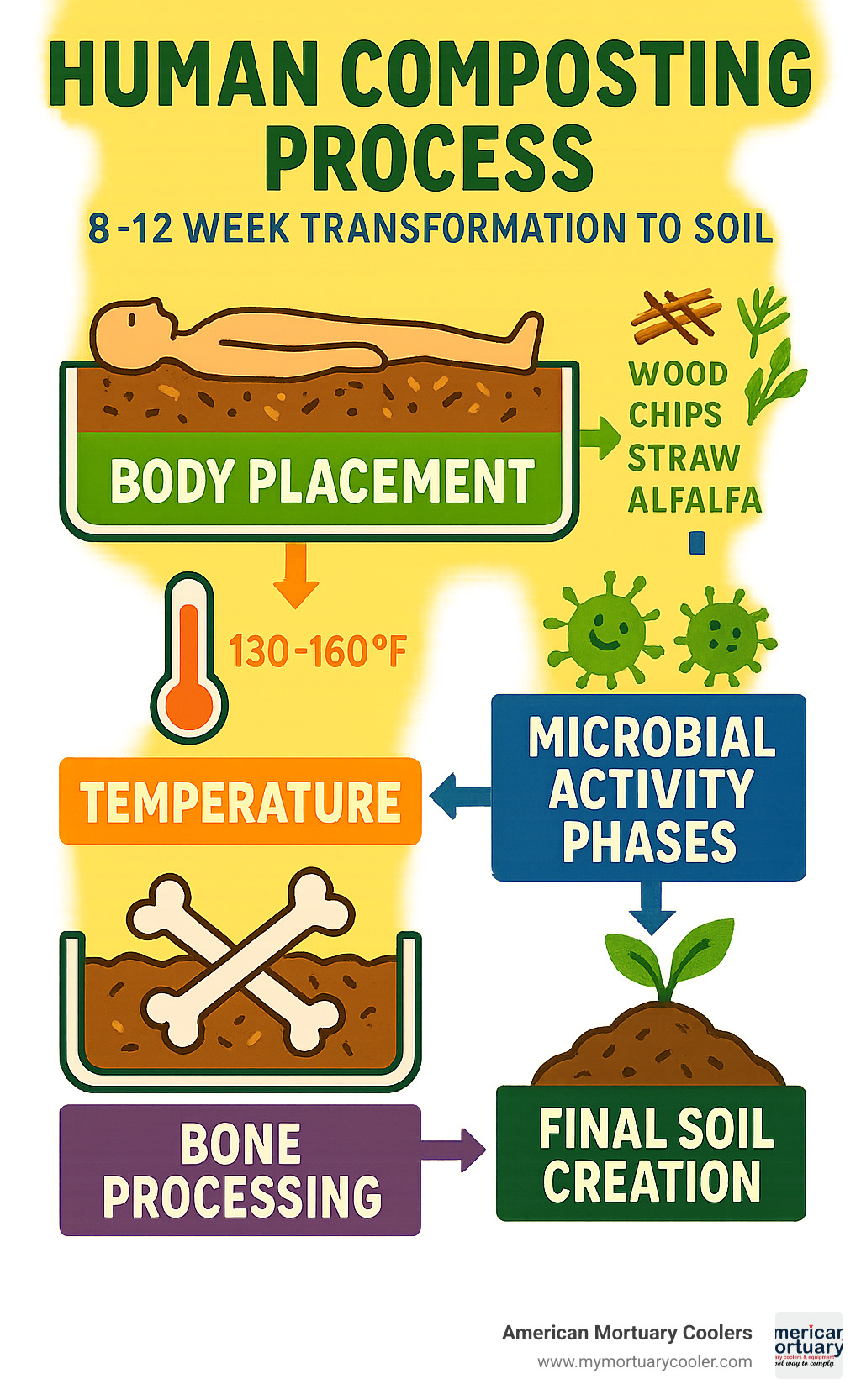
How to Compost a Body: Safety Foundations & Core Science
When funeral directors ask us how to compost a body safely, we always start with the science. The process isn't mysterious - it's actually quite neat in its simplicity.
Thermophilic microbes are the real heroes here. These heat-loving bacteria naturally live on our bodies and in organic materials like wood chips and straw. When conditions are right, they get to work breaking down organic matter while generating temperatures between 130-160°F. This heat isn't just a byproduct - it's nature's sterilization system.
The magic happens when you achieve the perfect carbon-to-nitrogen ratio of 30:1. Think of it like a recipe: human bodies provide the nitrogen, while materials like wood chips, straw, and alfalfa bring the carbon. Get this balance right, and the microbes thrive. Get it wrong, and you'll have odors or slow decomposition.
Temperature control separates successful composting from disaster. The environment must stay between 130-150°F for at least 72 hours to eliminate dangerous pathogens like E. coli and Salmonella. The beautiful thing is this heat occurs naturally when microbes are happy and working hard.
Oxygen flow and moisture levels need constant attention. The composting mixture should feel like a wrung-out sponge - about 50-60% moisture content. Too wet creates stinky anaerobic conditions. Too dry stops microbial activity completely. Proper aeration keeps everything aerobic, preventing methane buildup and foul odors.
Safety requires knowing when to say no. Bodies affected by prion diseases like Creutzfeldt-Jakob disease cannot be composted safely. These infectious proteins survive high temperatures that kill other pathogens. Scientific research on thermophilic composting confirms that while most pathogens die at composting temperatures, prions need special disposal methods like incineration.
Pre-Composting Preparations
Before learning how to compost a body, you need proper preparation. Body transport follows strict state regulations, usually requiring refrigerated vehicles and proper documentation. Most facilities keep bodies at 36-39°F until composting begins.
The deceased gets wrapped in a biodegradable shroud made from natural fibers like cotton, linen, or wool. Synthetic materials don't break down and interfere with the process. Some families participate in this wrapping ceremony, creating a meaningful goodbye ritual.
Removal of implants requires careful attention. Pacemakers, artificial joints, and dental work get extracted and recycled when possible. Small items like dental fillings might stay and get filtered out during final screening.
Facility permitting varies by state but typically needs environmental health approval, zoning compliance, and regular inspections. Operators must show proper ventilation, drainage, and safety measures. The carbon footprint reduction benefits often help win community support during permitting battles.
Monitoring & Quality Control
Successful human composting demands careful watching throughout the 8-12 week process. Temperature probes inserted into the composting mass track internal heat, ensuring the thermophilic phase reaches and maintains proper temperatures. Digital data loggers record continuous readings for regulatory compliance.
Oxygen sensors monitor aerobic conditions within vessels or piles. Levels must stay above 5% to prevent anaerobic decomposition that creates methane and terrible smells. Automated aeration systems or weekly turning schedules maintain proper oxygen flow.
This weekly mixing ensures uniform decomposition and prevents cold spots where pathogens might survive. It also redistributes moisture and introduces fresh oxygen throughout the mass. Specialized equipment designed for human composting makes this task more manageable and dignified.
Lab pathogen screening happens at multiple stages. Initial testing confirms absence of specific diseases, while final compost samples undergo comprehensive analysis for bacterial, viral, and parasitic contamination. Only pathogen-free soil gets released to families or conservation projects.
The 3-5 week curing phase follows active composting. During this time, soil continues stabilizing while temperatures gradually drop below 110°F. This curing ensures the final product is safe, stable, and ready for memorial gardens.
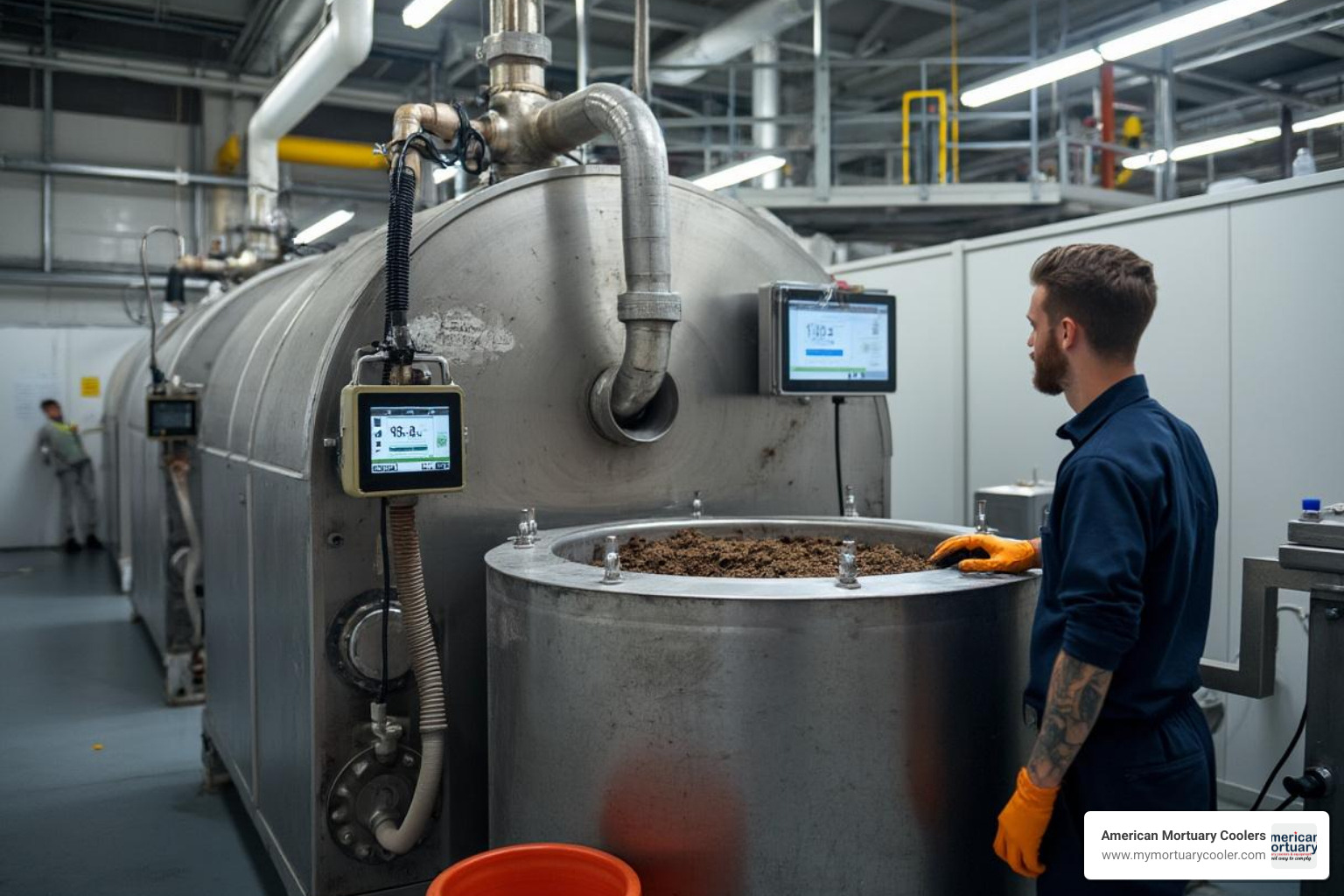
5 Proven Methods that Guarantee Results
When families ask how to compost a body, theyre often surprised that more than one approach exists. Below is a streamlined look at the five systems now operating legally in the U.S. and abroad. Each reaches the same end0point6safe, fertile soil6while differing in equipment, timeline, and family participation level.
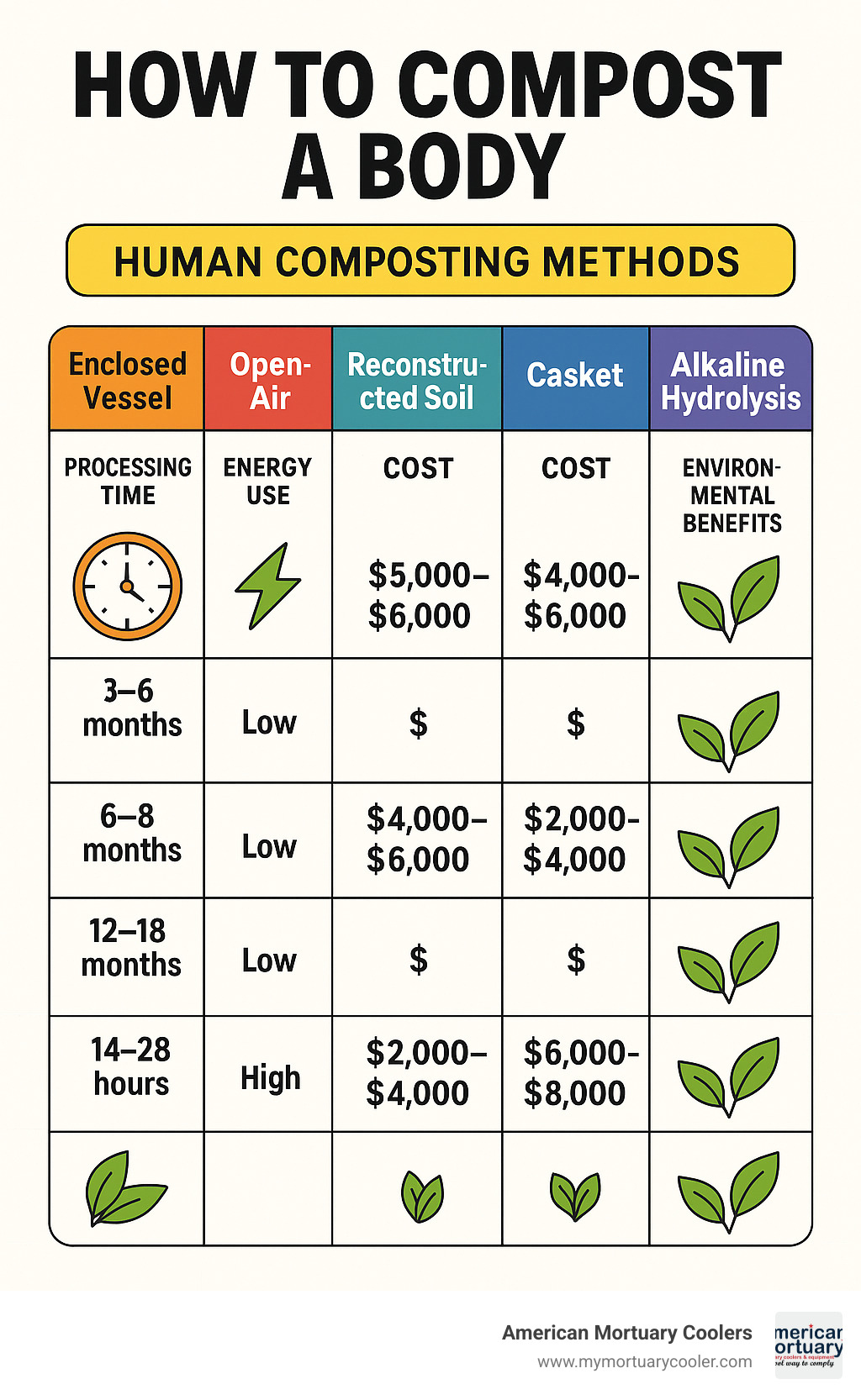
Method 1: Enclosed Vessel Natural Organic Reduction
The most widely adopted system uses a sealed stainless0steel vessel roughly 8240ft. The body, wrapped in a biodegradable shroud, is surrounded by a calibrated blend of wood chips, alfalfa, and straw to hit the ideal 30:1 carbon0to0nitrogen ratio. Sensors track temperature and oxygen; automated fans keep the mix at 1301609F. After 57 weeks of active composting, the material is screened, bone fragments are reduced to powder, and a 350week curing stage finishes the cycle. Families receive about one cubic yard of soil.
Method 2: Large6Scale Aerated Terramation Windrow
Facilities like Return Home line rows of aerated vessels that remain open to family visits. Each body spends about 30 days in active aeration and 30 days resting. Staff turn and moisten the mix weekly; families can place flowers, notes, or keepsakes on top of the vessel without disrupting the process. At day 60 the finished soil can be taken home or donated to reforestation projects.
Method 3: On6Site Green Burial with Compost Amendments
For cemeteries wanting a low6tech option, a body is placed in a 340ft0deep grave with no embalming and covered by native soil blended with straw or leaf litter. A straw cap controls odor while allowing airflow. Decomposition is complete in 612 months6decades faster than conventional burial. Trees or wildflowers can be planted directly over the plot, turning the site into a living memorial.
Method 4: Freeze6Dry Promession Technique
Developed in Sweden, promession uses liquid nitrogen to freeze the body solid before gentle vibration shatters it into a dry powder. After vacuum0drying, the remains are buried in a shallow biodegradable urn where they compost in 612 months. Specialized equipment and current U.S. regulations limit availability, but several states are evaluating pilot programs.
Method 5: Alkaline Hydrolysis + Soil Integration
Also called water cremation, alkaline hydrolysis dissolves soft tissues in a pressurized 2009F alkaline bath within hours. The sterile liquid6rich in amino acids and minerals6is blended with wood chips to create high6quality compost, while the remaining bone dust can be returned to the family or added to the soil. Total turnaround, including a short curing period, is generally under four weeks.
Environmental & Practical Benefits vs. Burial & Cremation
How to compost a body offers compelling environmental advantages over traditional disposition methods. Each human composting event prevents approximately one metric ton of CO₂ from entering the atmosphere compared to conventional burial or cremation. This reduction comes from eliminating fossil fuel consumption, avoiding concrete vault production, and preventing methane emissions from anaerobic burial decomposition.
Energy consumption comparison reveals dramatic differences between methods. Human composting uses only 1/8 the energy required for flame cremation, which burns fossil fuels at temperatures exceeding 1,800°F for 2-3 hours per body. The composting process relies on natural microbial heat generation, requiring only electricity for aeration and monitoring systems.
Traditional burial creates environmental problems through embalming chemical use. The funeral industry consumes over 800,000 gallons of toxic formaldehyde, methanol, and other preservatives annually in the United States. These chemicals leach into groundwater and soil, creating long-term contamination that affects local ecosystems.
Each composted body yields one cubic yard of nutrient-rich soil weighing 500-1,000 pounds. This soil contains essential plant nutrients including nitrogen, phosphorus, and potassium, making it valuable for gardening, landscaping, and conservation projects. Families report using the soil to plant memorial trees, create gardens, and restore degraded landscapes.
Conservation organizations increasingly accept donated human compost soil for ecosystem restoration projects. Return Home's 8-acre woodland demonstrates how human composting can contribute to reforestation efforts while providing meaningful memorial spaces for families.
The process also eliminates casket production environmental costs. Traditional burial caskets require hardwood harvesting, metal mining, and manufacturing processes that generate significant carbon footprints. Biodegradable shrouds used in composting require minimal resources and decompose completely.
Land use efficiency favors composting over traditional cemeteries. Burial grounds require permanent land dedication, ongoing maintenance, and eventual expansion as populations grow. Composting facilities can process thousands of bodies annually on relatively small footprints while producing beneficial soil amendments.
Water conservation represents another advantage. Traditional burial in arid regions requires irrigation for cemetery maintenance, while cremation facilities need water for cooling systems and emissions control. Composting requires minimal water input beyond maintaining optimal moisture levels in the composting mass.
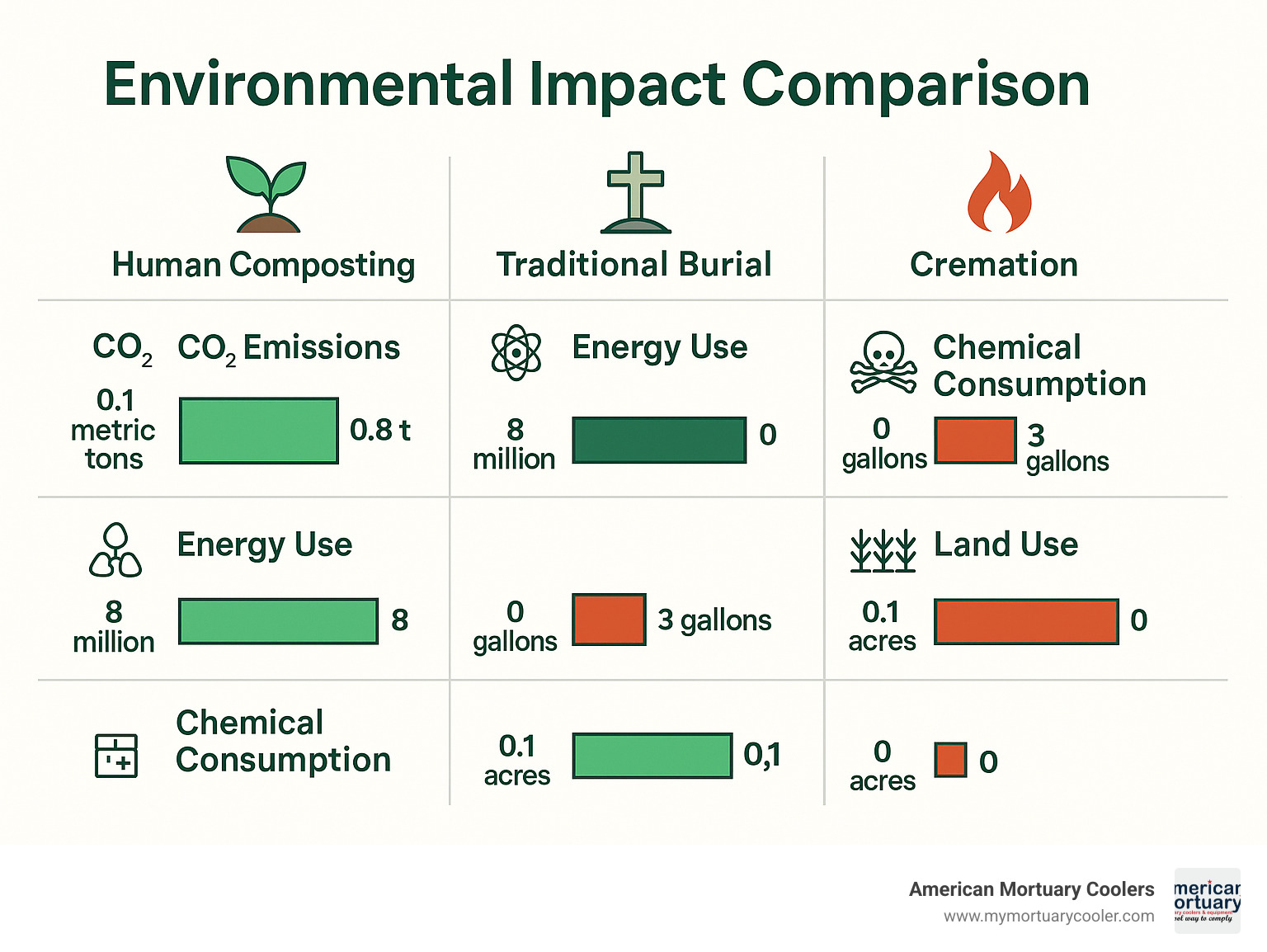
Legal, Ethical & Financial Landscape
Since Washington legalized human composting in 2019, 12 states6Washington, Colorado, Oregon, Vermont, California, New York, Nevada, Maine, Delaware, Maryland, Arizona, and Minnesota6have adopted similar statutes, and bills are active in many more. All require licensed facilities, temperature logs, pathogen testing, and transparent consumer contracts. For state0by0state details, see our California body composting laws guide.
Price is another driver. A conventional burial now averages $8,300; flame cremation with services sits around $7,000. Human composting typically runs $4,0007,000, often including delivery of the finished soil. Families therefore save money and carbon at the same time.
Religious response is mixed. The U.S. Conference of Catholic Bishops has voiced concern, while many Protestant, secular, and eco6focused groups endorse the option. Jewish and Islamic traditions generally require burial within 240hours, making current composting timelines impractical.
How to Compost a Body Legally in Your State
The workflow mirrors other dispositions:
- A licensed funeral director files the death certificate and secures medical6examiner clearance if needed.
- Refrigerated transport moves the body to a permitted composting facility.
- Operators document vessel loading, temperature logs, turning schedules, and lab results. Records are retained 5100years, depending on state rules.
- Independent lab tests confirm the soil is pathogen6free before it is returned, donated, or scattered on approved land.
Working with Licensed Providers & Facilities
Reputable providers invite tours, publish pricing online, and supply progress updates during the 8120week cycle. Pre6planning contracts lock in todays rates and reduce stress for survivors. Because American Mortuary Coolers delivers custom refrigeration and composting prep equipment nationwide, we routinely collaborate with leading operators in the Southeast, Midwest, and Pacific regions to help them meet these regulatory standards.
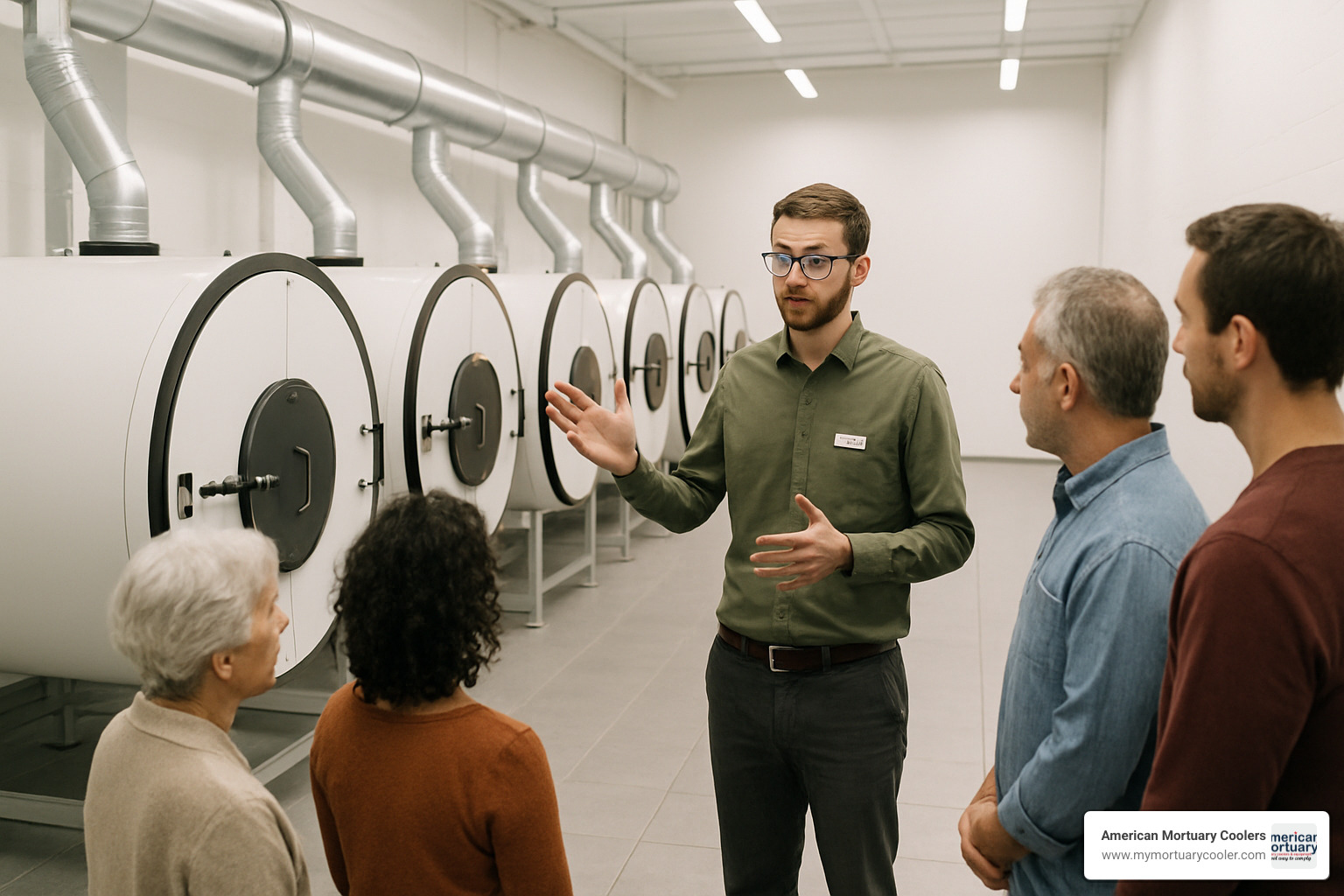
Frequently Asked Questions about Human Composting
Below are concise answers to the questions we hear most often from families and funeral directors.
What happens to bones, teeth and implants?
After the active phase, remaining bone pieces are mechanically reduced to a fine powder and remixed with the soil so every part of the body returns to the earth. Pacemakers are removed ahead of time; metal orthopedic hardware is screened out and recycled. Dental gold or amalgam is separated during screening and may be returned or recycled.
How much soil is produced and how can we use it?
Expect about one cubic yard (roughly 50061,0000lb). Most families use a portion in memorial gardens, tree plantings, or potted plants and donate the rest to habitat6restoration projects.
How long does the process take?
Standard enclosed6vessel NOR averages 812 weeks: 57 weeks of active thermophilic composting followed by 35 weeks of curing and lab testing. Larger bodies, cooler room temperatures, or facility backlogs can add a week or two, but providers will give you a target completion date.
Conclusion
The journey of understanding how to compost a body reveals a profound shift happening in American death care. What once seemed impossible - changing human remains into life-giving soil - has become a scientifically proven, legally recognized alternative that honors both our loved ones and our planet.
Through our work at American Mortuary Coolers, we've seen funeral directors from Tennessee to Los Angeles grapple with families' growing demand for green options. The five methods we've explored offer real solutions: enclosed vessel natural organic reduction provides controlled, dignified processing in 8-12 weeks, while aerated windrow systems allow family participation throughout the journey. Green burial with amendments bridges traditional and modern approaches, freeze-dry promession offers innovative technology, and alkaline hydrolysis integration combines speed with environmental benefits.
The numbers tell a compelling story. Each composted body prevents one metric ton of CO₂ emissions while using 87% less energy than cremation. The process yields one cubic yard of nutrient-rich soil - enough to nourish memorial gardens, restore damaged landscapes, or create living legacies that grow for generations.
Legal momentum continues building across America. From Washington's pioneering legislation to the recent expansions in Arizona and Minnesota, 12 states now recognize human composting as a legitimate death care option. Costs ranging from $4,000-$7,000 make it competitive with traditional burial while offering something burial cannot - the promise of new life.
We've watched families find unexpected comfort in receiving their loved one's soil. Some plant memorial trees, others create flower gardens, and many donate to conservation projects. This tangible outcome provides healing that traditional methods often cannot match. The deceased becomes part of the living world again, nourishing plants and supporting ecosystems for years to come.
For funeral directors considering these services, the technical requirements are manageable with proper equipment and training. The business opportunity is significant as younger generations increasingly seek sustainable options. For families exploring end-of-life choices, understanding how to compost a body opens doors to meaningful alternatives that align with environmental values.
The science is solid, the regulations are clear, and the benefits are proven. Whether through our comprehensive guide to body composting procedures or our detailed California body composting laws guide, the information exists to make informed decisions.
Human composting transforms our final act from environmental burden into environmental gift. It changes death from an ending into a beginning - the start of new forests, gardens, and wild spaces that will flourish long after we're gone. This isn't just about better death care; it's about better living, knowing our last contribution helps heal the world we leave behind.



